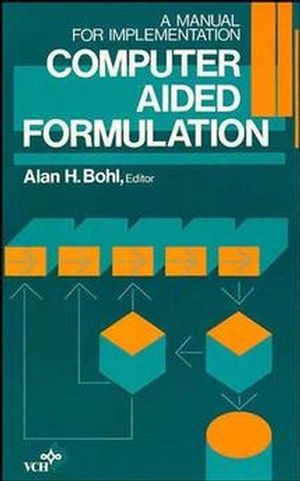Read more
Formulation chemists and engineers, along with their research managers, have long known the difficult nature of formulation problems. This book is a manual to help them to identify key issues, design efficient experiments, and develop math models to resolve conflicting objectives. Specific solved examples, co-authored by chemists, show how well these methods work on industrial-strength problems and document the power and efficiency of computer aided formulation.
This book is the first one to combine techniques of operations researching decision science, and statistics to solve formulation problems. Readers will appreciate its chapters on experimental design, which are easy to read and enjoyable.
List of contents
Author's Note on Text
Contributors
Chapter 1
The Formulation Problem
Introduction
Basic Principles of Formulating
Many Ingredients
Measuring Product Quality
Conflicting Goals
Additional Challenges
Identifying Experimental Variables
Implicit Formula and Process Constraints
Alternate Forms of Independent Variables
Controlling the Effects of Background Noise
Approaches to Formulation
The Artsy Approach
The Modeling-Graphical Approach
The Math-Programming Approach
Interactive Goal Programming
Prioritizing Goals
Math-Programming Format
Computer Aided Formulation
Expert Systems
Other Expertise Needed
Implementation
Summary
Definitions
Bibliography
Chapter 2
The Experimental Process
Introduction
Defining the Experimental System
Independent Variables
System Parameters
Uncontrolled Variables
System Constraints
Summary
Definitions
Bibliography
Chapter 3
Experimental Design
Introduction Experimental Models
One-Factor-at-a-Time (OFAT) Designs
Search Approaches to Experimental Design
Two-Factor-at-a-Time (TFAT) Designs
Factorial Designs
Partial Factorial Designs
Practical Considerations
Box-Wilson Designs
Simplex Centroid Designs
Summary
Definitions
Bibliography
Chapter 4
Fundamentals of Math Programming
Introduction
Math Programming
Linear Programming
Product Mix
Blending
Transportation
Multiperiod Scheduling
Portfolio Selection
Covering
Linear Programming Modeling
Linear Programming Formulation
The Graphical Solution
Sensitivity Analysis
Economic Impact of Changes to Right-Hand-Side Values
Computation of Dual Prices
Computation of Right-Hand-Side Ranges
Reduced Costs
Nonlinear Programming
Multiple Objectives Models Goal Programming
Summary
Definitions
Bibliography
Chapter 5
Multiple Goal Decision Methods
Introduction
Multiple Objective Scenarios
Multiobjective Optimality
Finding Efficient Solutions
Decision Space versus Objective Space
Utility Analysis
Problems in Comparing Alternatives
What Is Utility?
Assessing Single Objective Utility
Using Utility to Compare Alternatives
Preference Structure
Ranking and Weighting
Utility Curves
Multiobjective Decision Approaches
The Weighting Method
The Goal Approach
Multiattribute Utility Analysis
Summary
Definitions
Bibliography
Chapter 6
Expert System Design
Principles and Solved Example
Developing Effective Regression Models
Solved Example
Background
Experimental Objective
Working Hypothesis
Experimental System
Testing
Regression Modeling
Measured Moistness versus Variables Listed
Interactive Nonlinear Goal Programming
Objective Function
Constraints
Goal Constraints
Interactive Process
Conclusion
The Integrated Expert System
Summary
Definitions
Bibliography
Appendix 6.1
Appendix 6.2
Chapter 7
An Analytic Hierarchy Approach for Evaluating Product Formulations
Introduction
The Analytic Hierarchy Process
An Example of the Process
Extensions to the Analytic Hierarchy Process
An Alternative Approach to Evaluate Product Formulations
Summary
Definitions
Bibliography
Appendix 7.1
Chapter 8
Plastics Compounding and Formulation
Introduction
Getting Started
Overview of the Formulation Problem
Selection of the Polymer
A General Overview of Polymers
Polymer Properties and Screening Tests
Additives Used in Compounding Plastics
Some Tips to Speed the Work
Solved Example
Summary
Definitions
Bibliography
Chapter 9
Formulating Laundry Detergents
Detergent Performance
Bleaching and Brightening
Freshening
Fabric Softening
Soils
Fabrics
Product Safety
Product Stability
Processing
Formulating Fundamentals
Particulate Soils
Oily Soils
Starchy S
About the author
Alan H. Bohl is the author of Computer Aided Formulation: A Manual for Implementation, published by Wiley.
Summary
Formulation chemists and engineers, along with their research managers, have long known the difficult nature of formulation problems. This book is a manual to help them to identify key issues, design efficient experiments, and develop math models to resolve conflicting objectives. Specific solved examples, co-authored by chemists, show how well these methods work on industrial-strength problems and document the power and efficiency of computer aided formulation.
This book is the first one to combine techniques of operations researching decision science, and statistics to solve formulation problems. Readers will appreciate its chapters on experimental design, which are easy to read and enjoyable.

